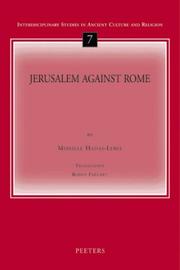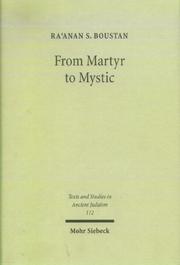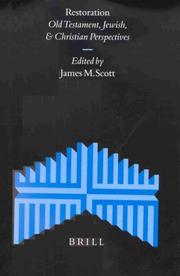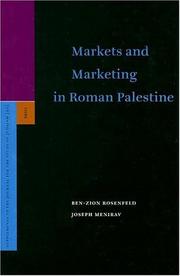| Listing 1 - 10 of 12 | << page >> |
Sort by
|
Book
ISBN: 9780521180986 Year: 2011 Publisher: Cambridge ; New York : Cambridge University Press,
Abstract | Keywords | Export | Availability | Bookmark
 Loading...
Loading...Choose an application
- Reference Manager
- EndNote
- RefWorks (Direct export to RefWorks)
Jewish magic --- Magic in rabbinical literature. --- History. --- Magie juive --- Magie dans la littérature rabbinique --- Histoire
Book
ISBN: 9781933379074 1933379073 Year: 2007 Publisher: Los Angeles : : Cherub Press, ,
Abstract | Keywords | Export | Availability | Bookmark
 Loading...
Loading...Choose an application
- Reference Manager
- EndNote
- RefWorks (Direct export to RefWorks)
Analogy in rabbinical literature. --- Midrash --- Cabala --- Mysticism --- Space and time --- Sacrifice in rabbinical literature. --- Judaism --- Analogie (Philosophie) --- Kabbale --- Mysticisme --- Espace et temps --- Sacrifice dans la littérature rabbinique --- History and criticism --- theory, etc. --- History --- Religious aspects --- Judaism. --- dans la littérature rabbinique --- Histoire et critique --- Histoire --- Judaïsme --- Aspect religieux --- Judaisme
Book
ISBN: 9781107032514 9781139506380 Year: 2013 Volume: *22 Publisher: Cambridge [etc.] Cambridge University Press
Abstract | Keywords | Export | Availability | Bookmark
 Loading...
Loading...Choose an application
- Reference Manager
- EndNote
- RefWorks (Direct export to RefWorks)
"This book studies the significance of sight in rabbinic cultures across Palestine and Mesopotamia (approximately first to seventh centuries). It tracks the extent and effect to which the rabbis living in the Greco-Roman and Persian worlds sought to appropriate, recast and discipline contemporaneous understandings of sight. Sight had a crucial role to play in the realms of divinity, sexuality and gender, idolatry and, ultimately, rabbinic subjectivity. The rabbis lived in a world in which the eyes were at once potent and vulnerable: eyes were thought to touch objects of vision, while also acting as an entryway into the viewer. Rabbis, Romans, Zoroastrians, Christians and others were all concerned with the protection and exploitation of vision. Employing many different sources, Professor Neis considers how the rabbis engaged varieties of late antique visualities, along with rabbinic narrative, exegetical and legal strategies, as part of an effort to cultivate and mark a 'rabbinic eye'"--
Vision in rabbinical literature --- Rabbinical literature --- Vision dans la littérature rabbinique --- Littérature rabbinique --- History and criticism. --- Histoire et critique --- Middle East --- Moyen-Orient --- Civilization --- Civilisation --- Vision in rabbinical literature. --- Vision dans la littérature rabbinique --- Littérature rabbinique
Book
ISBN: 0198744900 9780198744900 0191806013 0191062340 9780198866466 0198866461 Year: 2018 Publisher: Oxford, United Kingdom Oxford University Press
Abstract | Keywords | Export | Availability | Bookmark
 Loading...
Loading...Choose an application
- Reference Manager
- EndNote
- RefWorks (Direct export to RefWorks)
"Goy: Israel's multiple others and the birth of the gentile traces the development of the term and category of the goy from the Bible to rabbinic literature. Adi Ophir and Ishay Rosen-Zvi show that the category of the goy was born much later than scholars assume; in fact not before the first century CE. They explain that the abstract concept of the gentile first appeared in Paul's Letters. However, it was only in rabbinic literature that this category became the center of a stable and long standing structure that involved God, the Halakha, history, and salvation. The authors narrate this development through chronological analyses of the various biblical and post biblical texts (including the Dead Sea scrolls, the New Testament and early patristics, the Mishnah, and rabbinic Midrash) and synchronic analyses of several discursive structures. Looking at some of the goy's instantiations in contemporary Jewish culture in Israel and the United States, the study concludes with an examination of the extraordinary resilience of the Jew/goy division and asks how would Judaism look like without the gentile as its binary contrast"--Publisher's website.
Gentiles in the Bible --- Gentiles in rabbinical literature --- 296*11 --- 296*3 --- 296*13 --- 296*21 --- Rabbinical literature --- 296*21 Misjna --- Misjna --- 296*13 Midrasj --- Midrasj --- 296*3 Apocriefen --- Apocriefen --- 296*11 Tekstraditie van de Bijbel --- Tekstraditie van de Bijbel --- Gentiles in the Bible. --- Gentiles in rabbinical literature. --- Gentils dans la Bible. --- Gentils dans la littérature rabbinique. --- Nichtjude. --- Judentum. --- Gentiles (Jewish law).

ISBN: 9042916877 9789042916876 Year: 2006 Volume: 7 Publisher: Leuven Dudley, MA Peeters
Abstract | Keywords | Export | Availability | Bookmark
 Loading...
Loading...Choose an application
- Reference Manager
- EndNote
- RefWorks (Direct export to RefWorks)
Geschiedenis van de Oudheid --- Histoire de l'Antiquité --- Histoire et culture romaines --- Jodendom --- Judaïsme --- Romeinse geschiedenis en cultuur --- Rome in rabbinical literature. --- Jews --- Rabbinical literature --- Apocryphal books (Old Testament) --- Eschatology, Jewish --- Rome dans la littérature rabbinique --- Juifs --- Littérature rabbinique --- Apocryphes (Ancien testament) --- Eschatologie juive --- Persecutions --- Historiography. --- History and criticism. --- Theology. --- History of doctrines. --- Persécutions --- Historiographie --- Histoire et critique --- Théologie --- Histoire des doctrines --- Josephus, Flavius. --- Philo, --- Rome dans la littérature rabbinique --- Littérature rabbinique --- Persécutions --- Théologie --- Rome --- In rabbinical literature.
Book
ISBN: 9783161503382 3161503384 Year: 2010 Volume: 286 Publisher: Tübingen: Mohr Siebeck,
Abstract | Keywords | Export | Availability | Bookmark
 Loading...
Loading...Choose an application
- Reference Manager
- EndNote
- RefWorks (Direct export to RefWorks)
Prophecy --- Prophets in rabbinical literature --- Prophets in the New Testament --- Prophétie --- Prophètes dans la littérature rabbinique --- Prophètes dans le Nouveau Testament --- Judaism --- Christianity --- Judaïsme --- Christianisme --- 231.75 --- profetisme. Profetieën --- Conferences - Meetings --- 231.75 profetisme. Profetieën --- Prophétie --- Prophètes dans la littérature rabbinique --- Prophètes dans le Nouveau Testament --- Judaïsme --- Rabbinical literature --- Forecasting --- Prophecy - Judaism - Congresses --- Prophecy - Christianity - Congresses --- Prophets in rabbinical literature - Congresses --- Prophets in the New Testament - Congresses

ISBN: 3161487532 9783161487538 Year: 2005 Publisher: Tübingen Mohr Siebeck
Abstract | Keywords | Export | Availability | Bookmark
 Loading...
Loading...Choose an application
- Reference Manager
- EndNote
- RefWorks (Direct export to RefWorks)
Hekhalot-literatuur. --- Martyrdom --- Martyre --- Merkaba dans la littérature rabbinique. --- Merkaba-Mystik. --- Merkava in rabbinical literature. --- Merkavah-mystiek. --- Mysticism --- Mysticisme --- Märtyrer --- Ontstaansgeschiedenis. --- Rabbinismus. --- Judaism. --- Judaïsme. --- Judaism --- History. --- Judaïsme --- Histoire. --- Heikhalot rabbati --- Heikhalot rabbati. --- Hekhalot rabati. --- Maʻasé ʻaśārā harûgê malkût. --- Histoire et critique. --- History and criticism. --- Merkava in rabbinical literature --- 296*4 --- Hekhalot-literatuur --- Merkavah-mystiek --- Ontstaansgeschiedenis --- Dark night of the soul --- Mystical theology --- Theology, Mystical --- Spiritual life --- Negative theology --- Rabbinical literature --- Martyrdom (Judaism) --- 296*4 Joodse mystiek --- Joodse mystiek --- Judaism&delete& --- History --- Hekhalot rabati --- Sefer Hekhalot rabati --- Sefer Pirḳe Hekhalot --- Pirḳe Hekhalot

ISBN: 9004115803 9004493638 9789004115804 9789004493636 Year: 2001 Volume: 72 Publisher: Leiden;Boston BRILL
Abstract | Keywords | Export | Availability | Bookmark
 Loading...
Loading...Choose an application
- Reference Manager
- EndNote
- RefWorks (Direct export to RefWorks)
The restoration of Israel is one of those subjects which, although crucial to our understanding of early Judaism, has not received the focused attention it needs and deserves. These seminal essays, written by an international group of eminent scholars, introduce the reader to the subject of restoration in a roughly chronological approach, beginning with the formative period (the Old Testament), followed by the Greco-Roman period, formative Judaism, and early Christianity. These essays endeavor not merely to survey what is currently known about the subject from various vantage points, but rather to extend what is knowable in each case. This volume will stimulate much interest in the subject of restoration and will shape the future course of the scholarly discussion.
Restoration of the Jews in rabbinical literature --- Retour des Juifs en Palestine dans la littérature rabbinique --- Terugkeer van de Joden naar Palestina in de Rabbijnse literatuur --- Jews --- Judaism --- Restoration --- Biblical teaching --- History of doctrines --- History --- 933.3 --- -Jews --- -Judaism --- -Restoration of the Jews in rabbinical literature --- Rabbinical literature --- Religions --- Semites --- Hebrews --- Israelites --- Jewish people --- Jewry --- Judaic people --- Judaists --- Ethnology --- Religious adherents --- Geschiedenis van het Joodse volk: Tweede Tempelperiode--(538 v.Chr.-70 n.Chr.) --- -Biblical teaching --- -History of doctrines --- -Restoration --- Religion --- -933.3 --- 933.3 Geschiedenis van het Joodse volk: Tweede Tempelperiode--(538 v.Chr.-70 n.Chr.) --- -Religion --- Hellenistic Judaism --- Judaism, Hellenistic --- Restoration&delete& --- Bible --- Criticism, interpretation, etc. --- Biblia --- Criticism, interpretation, etc --- Post-exilic period, 586 B.C.-210 A.D.

ISBN: 9004140492 9789004140493 9789047416517 9047416511 Year: 2005 Volume: 99 Publisher: Leiden ; Boston : Brill,
Abstract | Keywords | Export | Availability | Bookmark
 Loading...
Loading...Choose an application
- Reference Manager
- EndNote
- RefWorks (Direct export to RefWorks)
The book presents a variety of topics relating to the market in Roman Palestine. The book deals with the main elements of commercial life - the different types of markets and the entities and figures that played a part in it. It portrays the process by which the flow of goods in the market occurs - from the end of the production process, via the entire range of middlemen, to the end user. A chapter is devoted to the pricing of merchandise in the economy of Roman Palestine. It offers a comprehensive framework which includes the techniques by which prices were determined and enforced. Other chapters deal with the image of the different market vendors, as viewed by the public and by the Jewish sages, and the commercial activity that took place in and around the synagogues. The book is based on a combination of rabbinic, literary and archaeological sources as well as epigraphic findings. It depicts the economy of Roman Palestine against the backdrop of the Roman Empire.
Markets --- Marketing --- Jews --- Marketing in rabbinical literature. --- Rabbinical literature --- Marchés --- Juifs --- Marketing dans la littérature rabbinique --- Littérature rabbinique --- History --- History and criticism. --- Histoire --- Histoire et critique --- Palestine --- Rome --- Economic conditions. --- Antiquities. --- Conditions économiques --- Antiquités --- 933.33 --- 908 <33> --- Geschiedenis van het Joodse volk: Romeinse tijd I; Masadah; vernieling van deTempel--(63 v.Chr.-70 n.Chr.) --- Heemkunde. Area studies--Oud-Palestina. Judea --- 908 <33> Heemkunde. Area studies--Oud-Palestina. Judea --- 933.33 Geschiedenis van het Joodse volk: Romeinse tijd I; Masadah; vernieling van deTempel--(63 v.Chr.-70 n.Chr.) --- Marchés --- Marketing dans la littérature rabbinique --- Littérature rabbinique --- Conditions économiques --- Antiquités --- Marketing in rabbinical literature --- Public markets --- Commerce --- Fairs --- Market towns --- Consumer goods --- Domestic marketing --- Retail marketing --- Retail trade --- Industrial management --- Aftermarkets --- Selling --- History and criticism --- 70-638 --- Economic conditions --- Antiquities --- To 1500
Book
ISBN: 0520080122 Year: 1993 Volume: 25 Publisher: Berkeley : University of California Press,
Abstract | Keywords | Export | Availability | Bookmark
 Loading...
Loading...Choose an application
- Reference Manager
- EndNote
- RefWorks (Direct export to RefWorks)
Human body --- Body, Human, in rabbinical literature --- Judaism --- Rabbinical literature --- Sex --- Sex in rabbinical literature --- Women in rabbinical literature --- Women in Judaism --- Corps humain --- Judaïsme --- Littérature rabbinique --- Femmes dans la littérature rabbinique --- Femmes dans le judaïsme --- Religious aspects --- History --- History and criticism --- Aspect religieux --- Histoire --- Histoire et critique --- 845 Religie --- -Sex --- -Body, Human --- -Women in Judaism --- -296*52 --- Jews --- Religions --- Semites --- Body, Human --- Human beings --- Body image --- Human anatomy --- Human physiology --- Mind and body --- Gender (Sex) --- Human sexuality --- Sex (Gender) --- Sexual behavior --- Sexual practices --- Sexuality --- Sexology --- Hebrew literature --- Jewish literature --- Women in the Talmud --- -Judaism --- -Joodse ethiek: Halacha; Minhag (gewoonten); Tora --- Religion --- Human body in rabbinical literature. --- Sex in rabbinical literature. --- Women in Judaism. --- Women in rabbinical literature. --- Judaism. --- History and criticism. --- 296*52 Joodse ethiek: Halacha; Minhag (gewoonten); Tora --- Joodse ethiek: Halacha; Minhag (gewoonten); Tora --- Judaïsme --- Littérature rabbinique --- Femmes dans la littérature rabbinique --- Femmes dans le judaïsme --- Human body in rabbinical literature --- 296*52 --- Religious aspects&delete&
| Listing 1 - 10 of 12 | << page >> |
Sort by
|

 Search
Search Feedback
Feedback About UniCat
About UniCat  Help
Help News
News